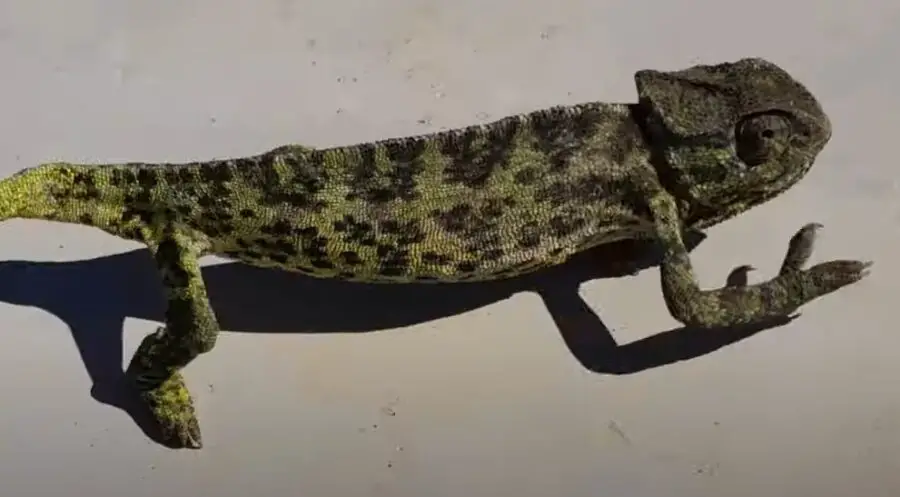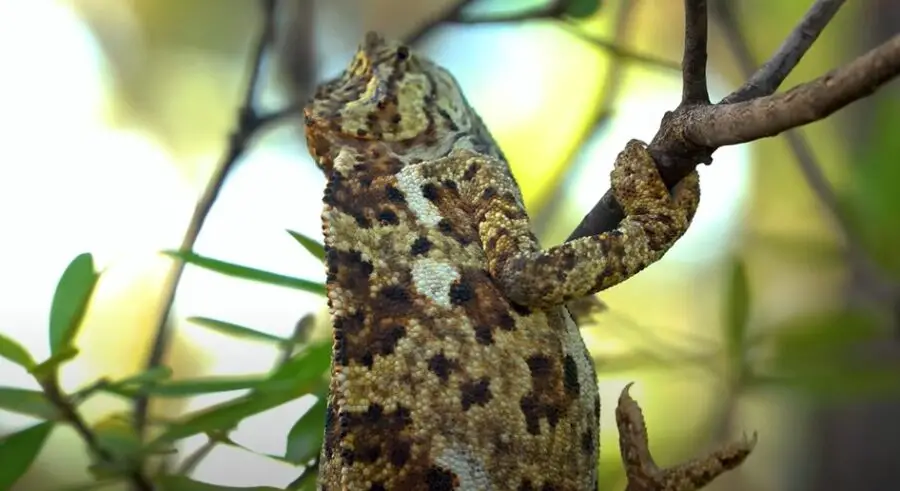Did your chameleon lose a nail or two? Are you concerned that your chameleon’s mobility will be hindered without the nail? In this article, we’ll find out if chameleons lose their nails and whether or not they grow back.
Do Chameleons Lose Their Nails? Yes. Chameleons commonly lose their nails when climbing the screen mesh and cage walls or digging. If the nail broke from the root, it may not grow back.

Do Chameleons Have Claws or Nails?
Chameleons have a split in their feet that looks like two main fingers in front. They are equipped with claws. We tend to interchange the words, “claws” and “nails”, but we are implying that they mean the exact same thing.
How Do Chameleon Nails Grow Back?
A chameleon’s nail could grow back the way it does with humans if the root is intact. The broken part of the old nail is pushed out by a new nail.
Keratin is contained in the nail cells to harden and flatten what is leftover after the break. If the root of the nail is damaged or the nail was pulled from the root when it got snagged in fencing or wire mesh, it may not grow back at all.
How Do Chameleons Lose Their Nails?
A chameleon in captivity is trying to make sense of its surroundings. It is natural to latch onto the branches you may have placed inside the enclosure, but chances are that the wiring, fencing or cage walls contain gaps that they can easily get their nails caught inside.
Here are three examples of chameleons losing or breaking their nails:
- Climbing wood
- Climbing screen walls
- Digging
1. Climbing Wood
The nails of a chameleon can firmly imprint themselves into the wood of branches. They are sharp and they hook into the wood to help them climb or attach themselves to blend into their surroundings while camouflaging themselves.
Accidents occur and nails get snapped in the wood. Depending on the depth and location of the break, the nail may or may not grow back. It could take weeks or months, but if the root of the nail is damaged or pulled, it may never happen.
2. Screen Walls
This is the most common way chameleons lose nails in their enclosures. The screen is obviously unnatural and your chameleon hasn’t learn to adapt to it.
The small holes in the screen offers no give to allow a snagged nail to smoothly release itself if it’s caught within. Your chameleon may try to pull harder with its sharp nails to cut the screen, but it will be unsuccessful.
If your chameleon pulls too hard or holds on to prevent falling by only the tip of a nail, it may break or get pulled entirely from the root.
3. Digging
Chameleons begin digging to find a place to lay eggs or they want a cool place to rest when the temperature rises too high.
They could end up hitting hard material like stones or pebbles while they dig. Twigs or any rough material may cause nail damage.
Scrapes, hits, snags and the complete loss of the nail may happen. Excessive digging may also shave off the nail slowly until it becomes a stub.
[youtube v=”FTtS7UHMuPA”]
Why Is My Chameleon’s Nail Not Growing Back?
The location of the break determines the likelihood of your chameleon being able to grow back a broken nail. The root could be damaged or snapped off. It will be impossible to grow a nail without its root intact.
If your chameleon is unable to grow back a nail, chances are that life will go on as normal. You may notice your chameleon having some issues such as:
- climbing less often
- losing digits
- lack of mobility
- stress
- refusal of food
It could depress your chameleon if they are unable to climb as frequently as they used to. You can rearrange the branches to make it easier for climbing.
If they resume climbing the screen walls and get fingers caught inside, they may pull and damage or lose them as well. A stressed chameleon could end up not moving much or refusing to eat.
Can I Help My Chameleon Grow Their Nails Back Faster?
You should inspect the location of the break. If there is a wound, you could apply an antiseptic ointment. If the nail area is inflamed or infected, seek medical assistance from a vet.
Add more calcium to your chameleon’s diet to help grow the nail again. Sprinkle or dust calcium powder on insects like crickets or superworms. You can also gut-load their food sources with more calcium and vitamin A before feeding your chameleon.

How Do I Prevent My Chameleon From Losing Its Claws?
Your chameleon wants to explore and adapt to its enclosure. Unfortunately, the wire mesh, screen walls or fencing around the space can make it easy for your chameleon’s nails to get caught inside. There are two suggestions we would like to offer below:
- Create more branch highways.
- Cover the mesh with laminated paper.
Branch Highways
Discourage your chameleon to climb on the wire mesh by adding more paths between branches. Add horizontal branches perpendicular to the ones you have set up already.
Create angles and levels with intricate branch highways to make it easy for your chameleon to get around without needing to climb screens.
Laminated Paper
The sides of the enclosure could be covered with clear laminated paper. Transparent paper or plastic sheeting can be tied or fastened to the screen walls.
Your chameleon will find these walls to be too slippery to attempt climbing them. Without anything to latch onto, the attention and direction will be focused on natural branches that are safer.
Conclusion
Your chameleon can lose a nail or two and continue to live a fulfilling life. You can create a safer space to limit the chances of further breaks.
The screen walls and their desire to climb them is the most common reason why they break their nails. Shallow breaks may grow back slowly over time. Deeper breaks may pull out the root and the nail may never grow back again.
Thank you for visiting HomePetHelp.com for all your informational needs surrounding chameleons and other reptiles. We invite you to stick around and check out many of our articles concerning any pets that you are interested in. Your chameleon is one of our favorites! See you soon!

